Behaviour of Shark Pattern in Forex

Vikas Singhania
Among the various charting options, candlestick is by far the most commonly used and favourite chart type in use. Little wonder then that candlestick type of charting has been in use since the 17th century. Japanese traders used candlestick in the rice markets.
It is not difficult to understand why candlesticks are popular among traders. Each bar has more information packed into it than the conventional bar chart or line chart. The bar captures the four important data points for the given period namely open, high, low and close. More importantly, they tell us the strength of the market movement for the day and foretell the possible movement for the next day.
Where candlestick scores over other chart types is that it has an uncanny way of picking up tops and bottoms of every move. There is always a candlestick pattern that is formed at small as well as major tops and bottoms. Unlike the western chart type using a bar or a line chart Japanese candlesticks pattern generally comprise of one, two or a maximum of three candles. The risk reward ratio offered by these patterns makes them attractive for traders.
But the problem for a young trader is one of plenty. Like a child in a candy shop, he is too much in awe of various charting patterns if not their names. Though there are numerous patterns that are followed by traders, some are more popular than other for their accuracy and simplicity in identification.
We look at five such candlestick patterns that are time-tested, easier to spot with a high level of accuracy.
Doji
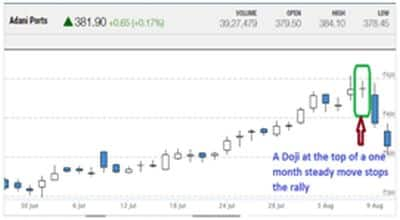
These are the easiest to identify candlestick pattern as their opening and closing price are very close to each other. The candle thus looks like a plus sign with a chance that the highs and lows wicks of the candle being of different lengths. These are neutral patterns. However, they gain significance if they appear after a period of steady buying or selling. By itself, a Doji signals an end of the previous move.
As the open and close are near the same level, it signifies the end of buying in an uptrend and an end of selling in a downtrend. This does not necessarily mean that there will be a V shaped move on the other side (this can be the case also), but brakes have been put to the previous trend. A doji occurring in a range bound movement has little significance. The following charts explain how a doji works.
Engulfing Pattern
A two candle pattern, engulfing pattern is one of the most powerful patterns in candlesticks. It occurs when the second candle (latest candle) completely overshadows the previous candle or completely engulfs the previous candle. Symbolically it means that buyers have overpowered the sellers or vice versa.
There is two type of Engulfing patterns – Bullish Engulfing Pattern and Bearish Engulfing Pattern.
Bullish Engulfing Pattern

As the name suggests a bullish engulfing pattern is a bullish indicator suggesting a possible up move. In this case, the second candle's body (a bullish one) completely engulfs the previous day's candle. Both the tails or wicks of the candle of the first bar is covered by the second candle.
The pattern suggests that bulls have taken over from the bears and are likely to start an up move. Such patterns are powerful if they are formed at the bottom of the correction in a bull move or near the bottom of a bear move. Such patterns are also seen at the end of a consolidation.
Bearish Engulfing Pattern
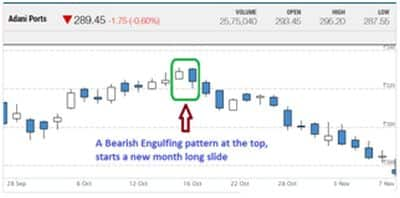
A bearish engulfing pattern is opposite of its bullish cousin. It occurs near the top of an up move or at the top of a correction move in an overall bear market.
The pattern signals that the bears have won the fight against the bulls and can push the stock downward.
The second candle (a bear candle) in a Bearish Engulfing Pattern engulfs the previous candle, which is smaller in size. Both the tails or wicks of the candle are covered (engulfed) by the bigger bear candle.
Morning Star
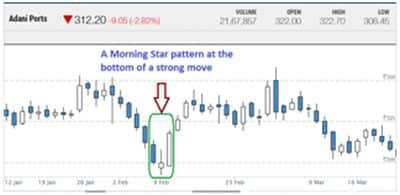
A Morning star is a bullish three candle pattern which is formed at the bottom of a down move. The first candle in the morning star formation is a big bearish candle which clearly defines the down move. The second candle is a small candle, which is ideally a Doji candle. The third candle is a large bullish candle which closes near the top of the day.
The pattern signifies extreme selling as witnessed in the first candle, followed by a change of power as shown in the second candle and finally the bulls taking over the and regaining lost ground.
Evening Star
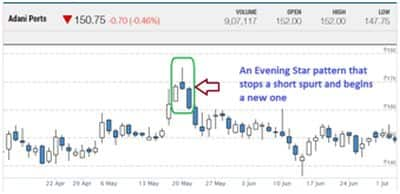
An exact mirror image of a Morning Star is an Evening Star. This occurs near the top of a rally and is a three candle formation.
The first candle is a long bullish candle which is followed by a small candle which ideally should be a Doji candle. The third candle is a long bearish candle which signals the end of the bull move.
The formation signals the change in power from the rampaging bulls in the first candle who is stopped at the second candle with a change of power being witnessed in the small Doji candle. The third big bear candle betrays the winner and the possible move going forward.
Hanging Man
Just like a two or three candle patterns, there are many one candle pattern that occurs at the tops and bottoms of the market move.
Among these are Doji (discussed earlier), Hammer, Inverted Hammer, Shooting Star and the Hanging Man. While all are equally significant in their appearance, we shall consider the Hanging Man, as it is an important pattern that appears near the top of the market.
This one candle pattern is formed at the end of an up move. The rally is near its exhaustion which leads to a sell-off in the opening hour of trading. The market, however, reverses and closes near the top, but it could either not cross the previous day's high or it barely does.
The morning sell-off suggests that the bull is losing control and may end up losing the fight going forward.
The candle has a small body at the top with the opening and closing being close to each other. By itself, it does not signal an end of the rally but forewarns of the coming danger. A crossover below the low of the Hanging Man pattern confirms the end of the rally.
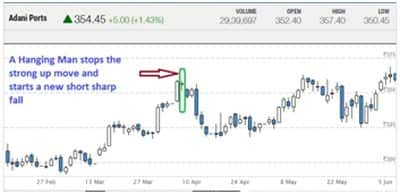
Candlesticks have stood the test of time. But like any trading strategy, the trader has to be sure of what he is seeking. It requires a bar-by-bar approach in trading candlesticks, naturally so because each candle has a story to tell. In case you missed one, probably you would miss the next big move.
(The writer is executive director Trade Smart Online)
Behaviour of Shark Pattern in Forex
Source: https://www.moneycontrol.com/news/opinion/top-5-candlestick-patterns-traders-must-know-2361239.html

0 Response to "Behaviour of Shark Pattern in Forex"
Post a Comment